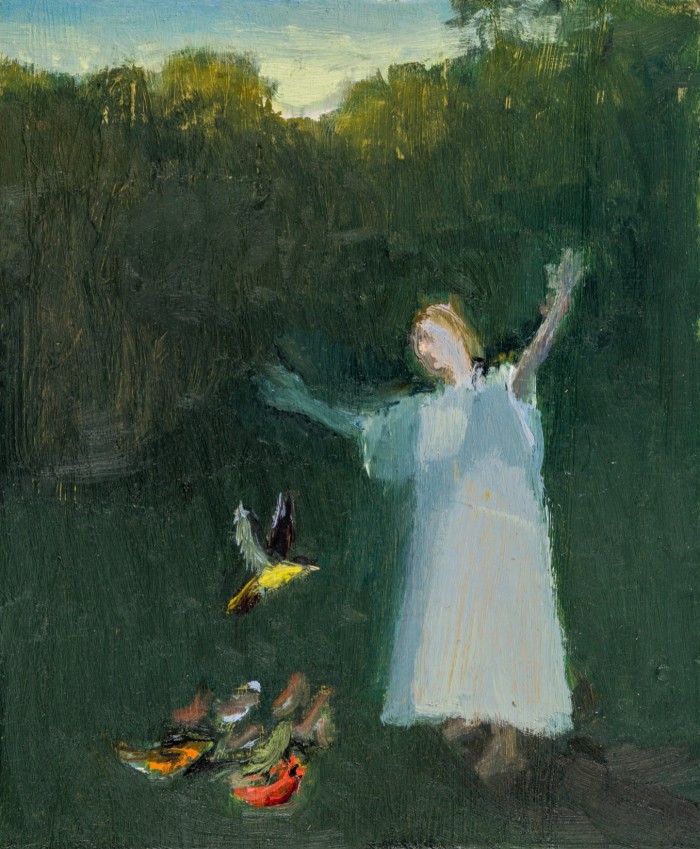What the birds have to tell us


Simply sign up to the Life & Arts myFT Digest -- delivered directly to your inbox.
For a string of mornings earlier this year, I would turn from my writing desk to catch a pair of mourning doves sitting on the ledge outside my apartment window. Their muted brown-grey wings and pale rosy breasts were like watercolours against the washed-out late winter sky. I quickly grew fond of these little visitors and found myself delighted whenever they swooped in. I’d inch slowly from my chair, because it seemed they could perceive my movement, darting their small heads to look directly at me. And when I was a little closer, I’d greet them in a cooing voice I guess I thought was bird appropriate.
I kept looking out for them weeks after they stopped coming. It wasn’t that I’d never seen mourning doves before — they’re one of the most common birds in America — but it’s not very often that I feel I’ve had a relationship with a bird, imaginary or not. It got me thinking about how many of us have lost that sense of reverence and appreciation for birds that humans had in earlier historical periods. Even if we don’t have the time or the inclination to become avid birdwatchers, paying more attention to the presence of these creatures might open us up to a bit more daily wonder.
In the gorgeously rich illustration “The Concourse of the Birds” (c1600), Persian artist Habiballah of Sava depicts a scene from the 12th-century poem by the Sufi poet Farid al- Din ’Attar. It’s an allegorical story about the coming together of all the birds in the world, who embark on a journey to find the simurgh, a mythical leader they imagine can address the world’s problems, ranging from “unrest” and “poisoned air” to “unhappiness”.

The illustration, part of an illuminated manuscript, is made in ink, opaque watercolour and gold and silver, and shows the birds meeting on a rocky patch of earth amid trees and shrubbery. There’s a white rooster, who reminds us of quotidian life, standing solo on a rock above a majestic-looking peacock, a pelican, a hawk and a pair of turtle doves. In the centre of the image there’s a crane, a magpie, a mallard and some geese. A green parrot and a black raven are perched beside a hoopoe, to whom all the other birds give their attention.
I love this illustration not simply for its sheer beauty, but also as an example of the long human tradition of connecting birds to the spiritual life, the seeking life. With their ability to fly and their proximity to the heavens, birds have been viewed by people across cultures and over time as messengers bearing vital information, assistance or solace from another realm. Certain birds, such as owls or ravens, offered signs of things to come. Among the oldest artistic renderings in human civilisation are cave drawings of a person with a bird head and of a bird perched on a stick. Both images were discovered in the cave of Lascaux, south-west France, and date from 16,000-14,000BC, and are thought by some to reflect the shamanistic practice of human intercession with the spiritual world.
We may no longer look to birds to prophesy the future, but that doesn’t mean they no longer have vital messages for us. Climate change is affecting the habitats, ecosystems and migratory patterns of birds around the world, all of which has ripple effects on their feeding, their reproduction, the competition for decreasing resources, and ultimately their ability to survive and play their role within nature’s ecosystem. So even today, birds provide clarion calls to us about the ravaging effects of the way we live — if we are willing to listen.
I love the 2022 painting “Teaching Birds to Fly”, by the 36-year-old artist Seth Becker, whose work is currently on view at New York’s LGDR gallery. It is a simple image of a figure — it is unclear whether it is a man or a woman — in a flowing white outfit standing in the grass, surrounded by a dense thicket of trees. Their arms are spread wide and raised high as if about to conduct a symphony. At the figure’s feet, gathered in a small huddle, is a flock of brightly coloured birds. One bird is hovering in the air just above the rest, its wings spread as though preparing to fly while its yellow breast illumines the painting like a small burst of light.

There is something gloriously playful about the picture’s conceit — after all, flying is something humans in myth and reality have always dreamt of, and would gladly learn from the birds. But there is a more ethereal reading of its substance: this white-clothed figure could be an angelic instructor showing these creatures how to use the bodies they’ve been created with, drawing to mind the old belief of birds existing in proximity to the divine.
However you see it, the image is a small reminder of the bond that can exist between birds and humans, and has for thousands of years. It also nudges us towards a renewed sense of closeness to the living creatures with whom we share the Earth. They are alive, and anything alive is its own miracle.
“The Goldfinch”, by the Dutch artist Carel Fabritius, one of Rembrandt’s students, is one of the most famous paintings in the world, made more so by Donna Tartt’s 2013 bestseller of the same name. Normally held in the Mauritshuis museum in The Hague, when it travelled to the Frick in New York in 2013, an estimated 200,000 people went to see it. It is a small painting of a life-sized goldfinch sitting atop a grey-blue bird feeder, set against a pale cream wall. Prized for their singing and their ability to be trained, goldfinches have been trafficked for hundreds of years. Today, they are under threat of extinction in some parts of the world, in part because of the incursions of poachers and trappers.
In the painting we view the bird side-on, its taupe and cinnamon head and body in contrast to the beautiful gold and black feathers of its wings. There is a thin strand of gold chain tied around its little leg, securing it to the feeder.
This particular painting is exquisite and commanding because, set against this sparse background, Fabritius manages to paint the goldfinch with an almost tangible sense of its own interiority. The bird seems to peer right at us, as we take in the fact it is held captive for our entertainment, and unable to fly as it was born to do. Our choices affect its existence and its sense of freedom; in its gaze is a reproach.
When we are not so consumed as to miss the daily wonders around us, I am curious what it is about us that feels entitled to capture and own beauty that would otherwise live freely. Perhaps a renewed appreciation of the birds that sing, fly and nest in the corners of our lives offers a way to reawaken the sense of awe and respect we owe to the world.
Follow Enuma on Twitter @EnumaOkoro or email her at enuma.okoro@ft.com
Follow @ftweekend on Twitter to find out about our latest stories first
Letter in response to this article:
Paean to the therapeutic benefits of birdwatching / From Jean-Jacques and Catherine Schul, Lasne, Belgium
Comments